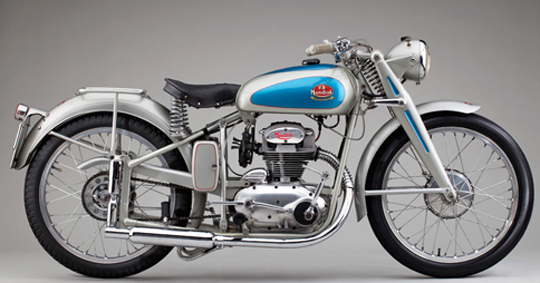 If you rank Italy on a wide range of manufactured products, from fashion to furniture to cars and motorcycles, the country is still ranking number one for artistic design quality. World War II is the reason why Italy became a 2-wheel country and started to produce some of the most beautiful motorcycles.
If you rank Italy on a wide range of manufactured products, from fashion to furniture to cars and motorcycles, the country is still ranking number one for artistic design quality. World War II is the reason why Italy became a 2-wheel country and started to produce some of the most beautiful motorcycles.
In 1945, Italy’s manufacturing industry was destroyed by intense plants bombing. With help from the government who authorized anyone at age of 14 to operate, unlicensed, any internal combustion vehicle not exceeding 50cc and able to travel at a top speed of 27 miles per hour, the need for mobility in an impoverished country pushed old and new manufacturers to produce cheap scooters, mopped and small size motorcycles.
And they did it, producing affordable motorcycles on a very large scale. In 1950, only 5 years after the end of the war, an outstanding 220 motorcycle manufacturers were competing on price and design originality. That year, 2-wheelers outnumbered cars by 1 million.
The 2 following decades demonstrated and exemplified to the rest of the world Italian motorcycle design excellence, and this until Japanese manufacturers invaded Italy offering larger, faster, quicker, and lower maintenance motorcycles like the hugely successful CB750 launched in 1969. The beautiful Italian motorcycles of the 50’s and 60’s are rarely seen in the US. It’s well worth taking again a glimpse at some of them. (more bikes after the jump)
 1951 Turismo 125 cc
1951 Turismo 125 cc
 1951 Bialbero Grand Prix 125 cc
1951 Bialbero Grand Prix 125 cc
 1952 Competition SS 52 125 cc
1952 Competition SS 52 125 cc
 1955 CSS Super Sport Volante 175 cc
1955 CSS Super Sport Volante 175 cc
 1955 Raid 160 cc
1955 Raid 160 cc
 1956 GrandSport Marianna 125 cc
1956 GrandSport Marianna 125 cc
 1959 Giuletta Super Sport 50 cc
1959 Giuletta Super Sport 50 cc
 1957 International Sport 160 cc
1957 International Sport 160 cc
 1963 Tresette Sprint 175 cc
1963 Tresette Sprint 175 cc
 1968 Record Sport 48 cc
1968 Record Sport 48 cc
 1969 Astor Super Sport 50 cc
1969 Astor Super Sport 50 cc


Errrrr … methinks an error was committed in the text . Fact is Italy already had a multitude of Larger , Faster and Quicker bikes … way before the Japanese invasion ever landed : such as M/V Agusta , Moto Guzzi etc . Fact it took awhile for the Japanese brands to catch up with Italian performance . What the Japanese brought to the party was Cheaper and More Reliable 😉
This is what small bore bikes should look like today.
Bellissimo!!
GuitarSlinger. You are wrong. At the time nobody in Italy built bigger bikes. No money. The country was devastated. All plants were bombed and flat on the ground. 5 years after the end of WW2, food/bread/milk was still given in priority to women with young children and elderly. You have no idea of what was Italy’s destruction. The big powerful bikes came much later after what Cyril is showing us.
Each time GuitarSlinger comments he is proven wrong. Anyway, beautiful bikes. Great feature.
Very cool bikes. A great source of inspiration for excellent retro design.
The 1st 2 ones are gorgeous.
I agree Greeko!
Great looking, yeah!
Beautiful bikes, thank you Cyril. Bikes from a time when the engine was also considered to be a beautiful part of the design. Unfortunately that day is now over with the exception of a few mfgrs. like Harley, Victory, Royal Enfield etc.
Awesome but how do you not show a ducati bevel single?the bike that originated desmo.hope it’s were you say after the jump.
Love to see the old stuff! Thanks Cyril. Love the ’59 50cc one, cool lines.
Love these little gems. If you are ever in Denver there is a private collection that the owner opens up to the public with a couple of hundred of Italian beauties like these. http://www.vintagemotos.com.
LOVE These!
Such sweet Italian Moto Eye Candy!
Thank you Cyril!
These are absolutely cool motorbikes. Aren’t anything like this available these days?
I’ve got a late 60’s Benelli 175 Scrambler (sold through Montgomery Wards under the Riverside name) that I’ve been building up as a cafe racer. What is remarkable is how many vintage Italian bikes have survived, and how much support there is for them. I was able to find an NOS racing seat, engine seals and gaskets, switchgear, and brakes all on eBay for fairly reasonable prices. And there are several shops around the globe selling NOS, reproduction, and used parts. One thing that makes it easier is that the Italians, like the Japanese, sourced parts like brakes, wheels, controls, electrical systems, and even some of the tinwork through just a few vendors. So, if I can’t find a “Benelli” part, often I can find one from a Ducati, Aprilia, etc. that’s the same part, and sometimes for cheaper.
These bikes are beautiful to look at and they’re fun to ride and work on.